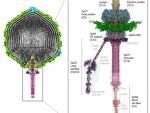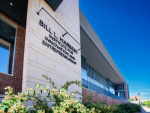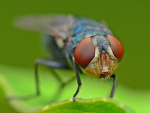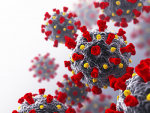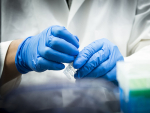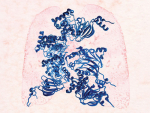Displaying items by tag: department of biochemistry and molecular genetics
This polygenic score predicts tamoxifen treatment resistance is better than conventional methods, with potential for personalized medicine application.
Tagged under
Bacterial viruses, known as phages, are the most abundant biological entities on the planet and are increasingly used as biomedicines to eradicate antibiotic-resistant pathogenic bacteria.
Tagged under
Research from the centers will help drive new knowledge and foster positive and lasting societal benefits.
Tagged under
Vivek Lal, M.D., associate professor in the Department of Pediatrics at UAB Heersink School of Medicine and the founder of both ResBiotic Nutrition and Alveolus Bio, was given the 2023 Award for Excellence in Entrepreneurship.
Tagged under
- release
- harbert institute for innovation and entrepreneurship
- school of medicine
- department of pathology
- department of pediatrics
- department of urology
- department of medicine
- division of pulmonary allergy and critical care medicine
- department of biochemistry and molecular genetics
- college of arts and sciences
- department of biology
- department of chemistry
- school of engineering
These nanowires, which can transport electrons to help a microbe make energy, were first described in a Geobacter bacteria; but now nanowires appear to be widespread in both bacteria and archaea prokaryotes.
UAB researchers have discovered a new way to treat melanoma by targeting CDC7 with EZH2 or BRPF1/2/3 inhibitors.
Tagged under
Tagged under
- release
- office of the president
- office of the provost for student and faculty success
- uab strategic plan
- school of medicine
- college of arts and sciences
- oneal comprehensive cancer center
- school of public health
- department of medicine
- division of infectious diseases
- department of surgery
- department of biochemistry and molecular genetics
- department of clinical and diagnostic sciences
- department of microbiology
- department of pharmacology and toxicology
- division of cardiovascular disease
- division of endocrinology diabetes and metabolism
- department of psychology
- department of environmental health sciences
Tagged under
- release
- advancement
- office of the president
- office of the provost for student and faculty success
- department of anesthesiology and perioperative medicine
- department of neurology
- department of biochemistry and molecular genetics
- department of cell developmental and integrative biology
- department of clinical and diagnostic sciences
- department of dermatology
- department of emergency medicine
- department of family and community medicine
- department of genetics
- department of medical education
- department of medicine
- department of microbiology
- department of neurobiology
- department of neurosurgery
- department of obstetrics and gynecology
- department of ophthalmology and visual sciences
- department of orthopaedic surgery
- department of otolaryngology
- department of pathology
- department of pediatrics
- department of pharmacology and toxicology
- department of physical medicine and rehabilitation
- department of psychiatry and behavioral neurobiology
- department of radiation oncology
- department of radiology
- department of surgery
- division of academic general pediatrics
- division of acute care surgery
- division of adolescent medicine
- division of advanced medical imaging
- division of anatomic pathology
- division of cardiothoracic surgery
- division of cardiothoracic anesthesia
- division of child abuse pediatrics
- division of clinical immunology and rheumatology
- division of community anesthesia
- division of diagnostic radiology
- division of developmental and behavioral pediatrics
- division of forensic pathology
- division of gastroenterology and hepatology
- division of gastrointestinal surgery
- division of general internal medicine
- division of general pediatrics and adolescent medicine
- division of genomics and bioinformatics
- division of gerontology geriatrics and palliative care
- division of gynecologic oncology
- division of hematology and oncology
- division of infectious diseases
- division of informatics
- division of laboratory medicine
- division of maternal fetal medicine
- division of molecular and translational biomedicine
- division of molecular imaging and therapeutics
- division of multispecialty anesthesia
- division of neonatology
- division of nephrology
- division of neuro oncology
- division of neuropathology
- division of pain medicine
- division of pediatric allergy and immunology
- division of pediatric hematology oncology
- division of pediatric cardiology
- division of pediatric critical care medicine
- division of pediatric dermatology
- division of pediatric emergency medicine
- division of pediatric endocrinology
- division of pediatric gastroenterology
- division of pediatric hospital medicine
- division of pediatric infectious diseases
- division of pediatric nephrology
- division of pediatric neurology
- division of pediatric oncology
- division of pediatric optometry
- division of pediatric pulmonary and sleep medicine
- division of pediatric rehabilitation medicine
- division of pediatric rheumatology
- division of pediatric surgery
- division of plastic surgery
- division of preventive medicine
- division of pulmonary allergy and critical care medicine
- division of reproductive endocrinology and infertility
- division of surgical oncology
- division of transplantation
- division of vascular surgery and endovascular therapy
- 1917 clinic
- acute care for elders unit
- addiction recovery program
- addiction recovery scholars
- alabama genomic health initiative
- all of us research program
- autism spectrum disorders clinic at uab
- center for addiction and pain prevention and intervention
- center for aids research
- center for clinical and translational science
- center for emerging drug discovery
- center for exercise medicine
- center for free radical biology
- center for interprofessional education and simulation
- center for genomic medicine
- center for low vision rehabilitation
- center for metabolic bone disease
- center for neurodegeneration and experimental therapeutics
- center for outcomes and effectiveness research and education
- center for palliative and supportive care
- center for pediatric onset demyelinating disease
- civitan international neuroimaging laboratory
- civitan international research center
- civitan sparks clinics
- comprehensive arthritis musculoskeletal and autoimmunity center
- comprehensive cardiovascular center
- comprehensive center for healthy aging
- comprehensive diabetes center
- comprehensive neuroscience center
- comprehensive stroke center
- comprehensive transplant institute
- deep south resource center for minority aging research
- gregory fleming james cystic fibrosis research center
- epilepsy center
- heflin center for genomic sciences
- hepatorenal fibrocystic diseases core center
- department of biomedical informatics and data science
- institute for cancer outcomes and survivorship
- legacy of hope
- liver center
- lung health center
- mcknight brain institute
- minority health and health equity research center
- mucosal hiv and immunobiology center
- multiple sclerosis center
- national spinal cord injury statistical center
- nephrology research and training center
- obesity health disparities research center
- obrien center for acute kidney injury research
- pancreatobiliary disease center
- parkinsons disease information and referral center
- pediatric pulmonary center
- precision medicine institute
- primary care research collaborative
- spain rehabilitation center
- school of medicine
The histone methyltransferase DOT1L — the potential target — is overexpressed in ovarian cancer, and high levels of expression correlate with reduced progression-free and overall survival.
Meier-Gorlin syndrome is a rare genetic developmental disorder that causes dwarfism, small ears, a small brain, missing patella and other skeletal abnormalities.
Everyone was fast this spring: the businesses that contributed to the fund, the scientists and physicians who crafted research proposals, and the senior School of Medicine researchers who chose which proposals got money.
Tagged under
The research is led by an Oregon cancer research institute, in collaboration with two biotech companies and the National Institutes of Health.
Tagged under
This discovery has implications in cancer, stem cell growth, and blood or neuron progenitor cell speciation.
Tagged under
Tagged under
In preclinical experiments, a metabolic inhibitor killed a variety of human cancer cells of the skin, breast, lung, cervix and soft tissues.
Tagged under
Tagged under
Tagged under
The Gilbert Family Foundation’s Gene Therapy Initiative funds researchers at UAB exploring developmental and curative therapies for NF1.
Tagged under
Safe and effective therapeutic agents that can treat these cancer-causing viruses are greatly needed.
Tagged under
Doctoral student Kwaku Osei came to UAB to learn from top researchers in the dry eye field. His work focuses on a tear film component that could provide a new way to treat a growing vision problem.
Tagged under

